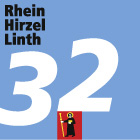Rhein–Hirzel–Linth
Overview
Intro
A short splash in the Obersee, the world becomes flat, the fields at March are huge, green and clearly laid out. The former floodplain has a well-developed motorway and railway system, electricity races through the area on dozens of cables.
Description
The multi-coloured slides in Pfäffikon are great fun for both children and adults. We’re talking about the Alpamare, of course. It opened in 1977 and was the largest covered water park in Europe at that time. It is well known, especially for its slides: tubes, rafting, or white water adventures – there is something for everyone. A while later you reach Lachen, which is said to be the town with the best sunset views on Lake Zurich. The lake glitters, sparkles and mirrors everything in sight, even the two-tower church zum Heiligen Kreuz. It was built more than 300 years ago according to the Vorarlberg architectural design. Just think about everything the church has withstood since then.
After crossing the tamed Wägitaler Aa, it is not far to the Nuoler Ried nature reserve. The area is flat and spacious, the fields are large and green. The Siberian iris with its big, deep blue flowers is particularly beautiful. Plovers, which are a rare sight now, build their well-camouflaged nests directly on the ground. And migratory birds often take a break from their travels here at Nuoler Ried. Efforts are underway on the Reumeren amphibian spawning site to keep industrialisation in check. Alpine newts live here, common toads, yellow-bellied toads, and frogs.
The Linth Canal flows through the Linth Plain. Since there is a lot of wind here, we have plenty of electricity. The Linth Plain was once under water and Lake Zurich and Lake Walen were connected. In the 18th century, possibly even earlier, the Plain was swamped again by floods, resulting in crop failures, poverty and disease. At the beginning of the 19th century the Linth was “corrected” under the direction of engineer Hans Conrad Escher and guided into Lake Walen via the Escher Canal. The grounds became fertile again and now you see tractors, storks and herons on the large fields. When the grass is freshly mowed, it is a delight to watch the birds during their primary occupation, which is looking for food.
Rather than watching, you would probably prefer to nibble at the “House of Läderach”. White chocolate, yellow chocolate, brown, red and black chocolate: of the many industrial buildings, this is without a doubt the sweetest and – better yet - located directly on the route. In the museum in Bilten you hear about the secrets of making chocolate. But you might want to stay on the bike path and continue to Niederurnen where you can buy a souvenir, such as a lovely “Glarner Tüechli” made in Glarus. A Glarner Tüechli is a colourful cotton square, a bandanna or a handkerchief, with a printed pattern. These are traditionally made in the Canton Glarus. The first textile factories in the Glarus area opened as early as 1740.
An enjoyable tour includes the careful planning of the same. Please inform yourself in advance at the local information center about the route and weather conditions. Depending on the season and weather conditions, this route may be blocked or interrupted
| Start location |
Pfäffikon SZ
|
|---|---|
| Destination |
Ziegelbrücke
|
| Ascent |
180 m
|
| Descent |
170 m
|
| Distance |
30 km
|
| Distance on tarred ways |
30 km
|
| Physical requirements |
Easy
|
Quick Facts
Route number






